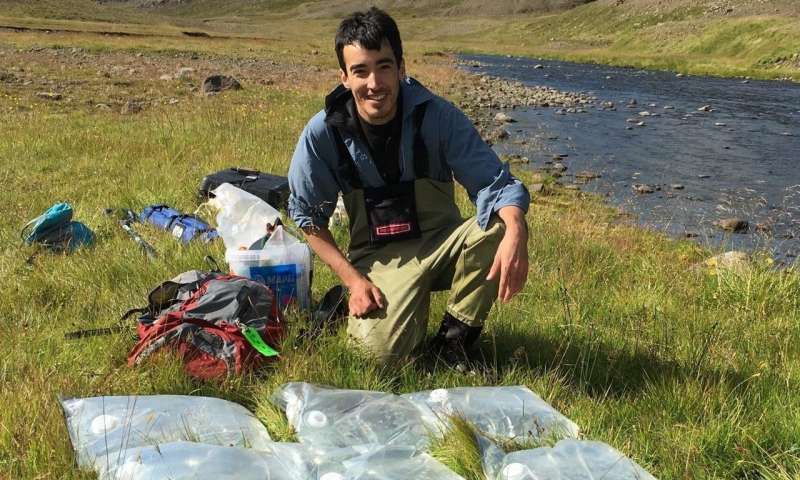Mark Torres. Credit: Rice University
Scientists have long thought oxygen appeared in Earth's lower atmosphere 2.7 billion years ago, making life as we know it possible. A Rice University researcher has added evidence to support that number.
The sulfur record held by ancient rock marks the dramatic change in the planet's atmosphere that gave rise to complex life, but rocks are local indicators. For the big picture, Rice biogeochemist Mark Torres used water that flows over and erodes the rocks as a proxy.
Torres, a Rice assistant professor of Earth, environmental and planetary sciences, and his colleagues report in Nature Geoscience that the balance of sulfur isotope anomalies in Archean rock, a marker of the "great oxygenation event," can also be recognized and measured in the rivers that erode it.
The researchers sampled water from two of the few places on Earth where Archean rock is exposed in abundance: at the Superior Craton in Canada and in South Africa. They determined that while individual samples of rock may still show an imbalance (the anomalies) of sulfur isotopes, careful analysis of the water that diffuses and transports sulfur from thousands of miles of rock to the ocean shows that the contents are ultimately in alignment with bulk Earth's sulfur signature.
"Changes in chemistry can tell you something about the environment, and rocks can tell you whether there was oxygen at a particular time," Torres said. "Early in our history, sulfur isotope anomalies are all over the place. Then, roughly 2.7 billion years ago, they disappear and they never come back."
Sulfur is a marker because four stable isotopes, known by their molecular masses of 32, 33, 34 and 36, can show different behaviors when present in the atmosphere. "Most sulfur is mass 32, but there are small amounts of the other masses," Torres said.
Ultraviolet light from the sun reacted with sulfur gas and split it into separate compounds with heavier and lighter isotopes. Eventually, these compounds sank into and remain in rock that formed at the time.
"But there's this weird thing: Really old rocks have more 33-sulfur in them than we would expect, based on the relative masses," Torres said. "Because 33 is one heavier than 32, we should easily be able to predict their relative abundances using physical chemistry. But, we find that 33 is way more abundant than expected. That's why we call it an anomaly."
When oxygen appeared, it absorbed ultraviolet light and quenched the sulfur reaction, as seen in the rock. That's all well and good, Torres said, but the theory doesn't account for anomalous sulfur that continued to leach from Archean rock into surface water, be carried to the ocean and then condense into new rock that would also have the anomaly.
"This recycling of ancient rock was a way to perpetuate the anomaly even after oxygen had arisen," he said. The researchers suspected persistence of the anomaly could blur understanding of the timing of oxygen's rise by as much as 100 million years.
It didn't, they discovered, but it wasn't easy. The team included researchers from the California Institute of Technology and the Center for Petrographic and Geochemical Research in Nancy, France. Members collected scores of samples from the Canadian sites to go along with South African samples they already had and checked their sulfur signature after eliminating the effects of contaminants from sulfurous acid rain, ice-melting road salt and dust from local mining operations. But their final calculations showed a robust balance in 33-sulfur collected by river runoff over a wide area.
"Our effort allows us to be confident we've got the timing for this great oxidation event, so now we can start to understand the mechanisms," Torres said. "If you think about the whole scope of Earth's history, 100 million years is small, but on the evolutionary timeline of organisms, it matters."
More information: Mark A. Torres et al, Riverine evidence for isotopic mass balance in the Earth's early sulfur cycle, Nature Geoscience (2018). DOI: 10.1038/s41561-018-0184-7
Journal information: Nature Geoscience
Provided by Rice University






















